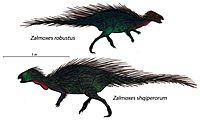Hateg Island facts for kids

Hațeg Island was a large offshore island in the Tethys Sea during the late Cretaceous. It was in an area now around modern-day Hațeg, Hunedoara County, Romania. Upper Cretaceous fossils of small-sized dinosaurs have been found in the former island's rocks.
The island was formed mainly by tectonic uplift during the early Alpine orogeny towards the end of the Cretaceous. There is no real present-day analog, but the island of Hainan (off the coast of China) is perhaps closest as regards climate, geology and topography, though still not a particularly good match. The vegetation, for example, was quite distinct from today, as was the fauna.
Hungarian paleontologist Franz Nopcsa (1877–1933) had the idea that "limited resources" found on the island often have an effect of "reducing the size of animals" over the generations, producing a localized form of dwarfism. Nopcsa's theory of island dwarfism – also known as the "island rule" – is today widely accepted.
Images for kids
-
The local macropredator Hatzegopteryx hunting the herbivore Zalmoxes
-
A restoration of Balaur bondoc and the forest vegetation found in Hațeg Island
See also
 In Spanish: Isla de Hațeg para niños
In Spanish: Isla de Hațeg para niños




